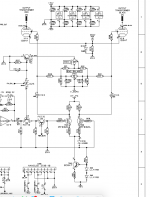Hello all
First post here, So go easy 🙂
I have an amp I'm trying to repair. I have a bit of experience with tube amps and know the dangers and safe way to work inside a chassis (to get that outta the way). It's a Blackstar HT5 and there is an earth hum. All voltages at the test points are correct, and there wasn't any damaged components. What I did find was the grid pins of the output tube was connected to ground while under power (no tube in). It stays connected for a few seconds once power switched off then isolates from earth. I have tested a few components in the chain between ground and the grid pin and they test OK to my knowledge. Its a twin triode tube and is earth is present on both grid pins when powered. Should the grid be connected to earth when powered? Below is the section of schematic with grid circuit.
TIA
AJStrummer
First post here, So go easy 🙂
I have an amp I'm trying to repair. I have a bit of experience with tube amps and know the dangers and safe way to work inside a chassis (to get that outta the way). It's a Blackstar HT5 and there is an earth hum. All voltages at the test points are correct, and there wasn't any damaged components. What I did find was the grid pins of the output tube was connected to ground while under power (no tube in). It stays connected for a few seconds once power switched off then isolates from earth. I have tested a few components in the chain between ground and the grid pin and they test OK to my knowledge. Its a twin triode tube and is earth is present on both grid pins when powered. Should the grid be connected to earth when powered? Below is the section of schematic with grid circuit.
TIA
AJStrummer
Attachments
> connected to ground while under power
> then isolates from earth.
> is earth is present on both grid pins when powered.
What is this "connected to ground", "earth is present"? Do you have zero Ohms, zero Volts, or a continuity beep?
> then isolates from earth.
> is earth is present on both grid pins when powered.
What is this "connected to ground", "earth is present"? Do you have zero Ohms, zero Volts, or a continuity beep?
Thanks for the reply PRP
Sorry if I wasn't clear in my description.
I am getting a continuity beep with 1 probe on the pin, and other to chassis, when the circuit is on. When power switched off, the continuity beep slowly dies.
Sorry if I wasn't clear in my description.
I am getting a continuity beep with 1 probe on the pin, and other to chassis, when the circuit is on. When power switched off, the continuity beep slowly dies.
If I get you right you are testing the grid not for voltage/current but for continuity -IE- resistance while powered up ---right ??
Thats not normal practice as an ohmeter basically is a current meter with a series battery to test for resistance of NON-active -IE --not powered up internal electronic components .
If you are testing that way you are lucky its not a sensitive part of a solid state design otherwise the internal resistance and battery current could adversely effect an ACTIVE amplifier .
Please tell me I have picked you up wrong ?
Thats not normal practice as an ohmeter basically is a current meter with a series battery to test for resistance of NON-active -IE --not powered up internal electronic components .
If you are testing that way you are lucky its not a sensitive part of a solid state design otherwise the internal resistance and battery current could adversely effect an ACTIVE amplifier .
Please tell me I have picked you up wrong ?
Thanks for your reply Duncan2
I was looking for a component leaking to ground. While probing the tube socket pins, after the amp was switched off I found the grid pins had continuity to ground. This disappeared as the amp cooled down, so I suspected a component was going open when amp powered up. Is this a possible scenario?
I was looking for a component leaking to ground. While probing the tube socket pins, after the amp was switched off I found the grid pins had continuity to ground. This disappeared as the amp cooled down, so I suspected a component was going open when amp powered up. Is this a possible scenario?
"Continuity" function and concept is for trailer lights.
As electronics technicians, we can use numbers. And units.
Also, checking continuity (or Ohms!) with power ON is liable to burn up your meter.
As electronics technicians, we can use numbers. And units.
Also, checking continuity (or Ohms!) with power ON is liable to burn up your meter.
Your amp's output tube has a negative bias voltage via it's grid. Your meter is likely reading that negative voltage and not detecting a short to ground. Switch the meter to DC voltage, you should detect a negative voltage. If you do, it s normal.
- Home
- Amplifiers
- Tubes / Valves
- Tube grid connected to ground, is this correct?
